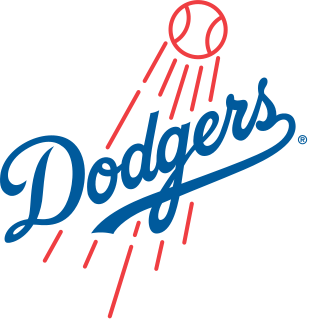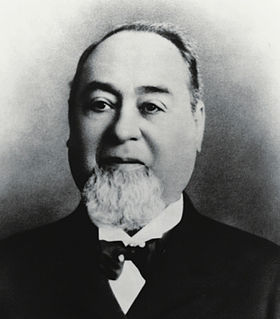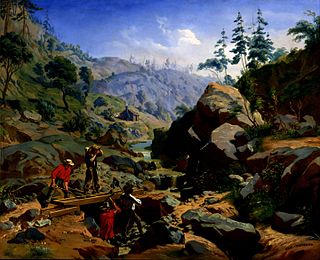Related Research Articles

The Los Angeles Dodgers are an American professional baseball team based in Los Angeles. The Dodgers compete in Major League Baseball (MLB) as a member club of the National League (NL) West division. Established in 1883 in the city of Brooklyn, which later became a borough of New York City, the team joined the NL in 1890 as the Brooklyn Bridegrooms and assumed several different monikers thereafter before finally settling on the name Dodgers in 1932. From the 1940s through the mid-1950s, the Dodgers developed a fierce cross-town rivalry with the New York Yankees as the two clubs faced each other in the World Series seven times, with the Dodgers losing the first five matchups before defeating them to win the franchise's first title in 1955. It was also during this period that the Dodgers made history by breaking the baseball color line in 1947 with the debut of Jackie Robinson, the first African-American to play in the Major Leagues since 1884. Another major milestone was reached in 1956 when Don Newcombe became the first player ever to win both the Cy Young Award and the NL MVP in the same season.

San Francisco, officially the City and County of San Francisco, is a cultural, commercial, and financial center in the U.S. state of California. Located in Northern California, San Francisco is the 17th most populous city in the United States, and the fourth most populous in California, with 873,965 residents as of 2020. It covers an area of about 46.9 square miles, mostly at the north end of the San Francisco Peninsula in the San Francisco Bay Area, making it the second most densely populated large U.S. city, and the fifth most densely populated U.S. county, behind only four of the five New York City boroughs. San Francisco is the 12th-largest metropolitan statistical area in the United States with 4.7 million residents, and the fourth-largest by economic output, with a GDP of $592 billion in 2019. With San Jose, California, it forms the San Jose–San Francisco–Oakland, CA Combined Statistical Area, the fifth most populous combined statistical area in the United States, with 9.6 million residents as of 2019. Colloquial nicknames for San Francisco include SF, San Fran, The City, and Frisco.

The California Gold Rush (1848–1855) was a gold rush that began on January 24, 1848, when gold was found by James W. Marshall at Sutter's Mill in Coloma, California. The news of gold brought approximately 300,000 people to California from the rest of the United States and abroad. The sudden influx of gold into the money supply reinvigorated the American economy, and the sudden population increase allowed California to go rapidly to statehood, in the Compromise of 1850. The Gold Rush had severe effects on Native Californians and accelerated the Native American population's decline from disease, starvation and the California genocide.

Dirty Harry is a 1971 American neo-noir action-thriller film produced and directed by Don Siegel, the first in the Dirty Harry series. Clint Eastwood plays the title role, in his first outing as San Francisco Police Department (SFPD) Inspector "Dirty" Harry Callahan. The film drew upon the real life case of the Zodiac Killer as the Callahan character seeks out a similar vicious psychopath.

Levi Strauss was a German-born American businessman who founded the first company to manufacture blue jeans. His firm of Levi Strauss & Co. (Levi's) began in 1853 in San Francisco, California.

The San Bernardino Mountains are a high and rugged mountain range in Southern California in the United States. Situated north and northeast of San Bernardino and spanning two California counties, the range tops out at 11,503 feet (3,506 m) at San Gorgonio Mountain – the tallest peak in all of Southern California. The San Bernardinos form a significant region of wilderness and are popular for hiking and skiing.

Bill Robinson, nicknamed Bojangles, was an American tap dancer, actor, and singer, the best known and the most highly paid African-American entertainer in the United States during the first half of the 20th century. His long career mirrored changes in American entertainment tastes and technology. His career began in the age of minstrel shows and moved to vaudeville, Broadway theatre, the recording industry, Hollywood films, radio, and television.

Californio is a term used to designate a Hispanic Californian, especially those descended from Spanish and Mexican settlers. California's Spanish-speaking community has resided there since 1683 and is made up of varying Spanish, Mexican, Mestizo, and Indigenous Californian origins. Alongside the Tejanos of Texas and Neomexicanos of New Mexico and Colorado, Californios are part of the larger Chicano/Mexican-American/Hispano community of the United States, which has inhabited the American Southwest and the West Coast since the 16th century.

Sidney Patrick Grauman was an American showman who created two of Hollywood's most recognizable and visited landmarks, the Chinese Theatre and the Egyptian Theatre.

The San Francisco Committee of Vigilance was a vigilante group formed in 1851. The catalyst for its formation was the criminality of the Sydney Ducks gang. It was revived in 1856 in response to rampant crime and corruption in the municipal government of San Francisco, California. The need for extralegal intervention was apparent with the explosive population growth following the discovery of gold in 1848. The small town of about 900 individuals grew to a booming city of over 20,000 very rapidly. This overwhelming growth in population made it nearly impossible for the previously established law enforcement to regulate any longer which resulted in the organization of vigilantes.
Ah Toy (亞彩 Taishanese: /a˧ tʰɔi˥/, Standard Cantonese: Aa3 Coi2, (May 18 [O.S. May 6], 1829 – February 1, 1928) was a Chinese–American prostitute and madam in San Francisco, California, during the California Gold Rush, and purportedly the first Chinese prostitute in San Francisco. Arriving from Hong Kong in 1848, she quickly became the best-known Asian woman in the Old West. She reportedly was a tall, attractive woman with piercing brown eyes.
Arthur Nahl was a German-born artist, daguerreotyper, engraver, portraitist, and landscape painter. Nahl was a painter known for his American Old West paintings of California. He was considered one of California's finest engravers, and was ranked amongst the best gymnasts in California for his time.

Piper's Opera House is a historic performing arts venue in Virginia City, Storey County, Nevada in the United States. Piper's served as a training facility in 1897 for heavyweight boxing champion Gentleman Jim Corbett, in preparation for his title bout with Bob Fitzsimmons. The current structure was built by entrepreneur John Piper in 1885 to replace his 1878 opera house that had burned down. The 1878 venue, in turn, had been to replace Piper's 1863 venue which was destroyed by the 1875 Great Fire in Virginia City. Mark Twain spoke from the original Piper's stage in 1866, and again a century later in the third venue, as portrayed by Hal Holbrook in his one-man play Mark Twain Tonight! A lynch mob hung a victim from the first venue's rafters in 1871. American theatrical producer David Belasco was stage manager at the second opera house before moving to New York City. Piper's opera houses played host to Shakespearean thespians such as Edwin Booth. Musical performers Lilly Langtry, Al Jolson and John Philip Sousa once performed here. In 1940, Errol Flynn auctioned off historic Piper memorabilia from the opera house stage, during a live NBC broadcast that coincided with the premiere of Flynn's new movie Virginia City.

Mary Elitch Long was one of the original owners of Elitch Gardens in Denver, CO. She was the first woman to own and manage a zoo -- the first zoo between Chicago and the west coast -- and one of the first women to own and manage a theater She was an author of two children's books and was inducted into the Colorado Women's Hall of Fame in 1996.
Joseph Andrew Rowe was an American equestrian and manager of circus companies. In 1849 he brought the first circus entertainment to West Coast of the United States, in San Francisco.
Charles Dorman Robinson was an American panorama, cyclorama, landscape, and marine painter. He is known for his seascapes and landscapes of Northern California, including over a hundred paintings of Yosemite Valley. He was known as "the dean of Pacific Coast artists".
The following is a timeline of the history of the city of San Francisco, California, United States.

Frederick August Wenderoth or F. A. Wenderoth was a German-born American painter and photographer. Born and educated in Cassel, where he first learned to paint from his father, he established a lifelong friendship with Charles Christian Nahl at school. During the 1840s period of political upheaval in Hesse, he moved to Paris, where he was joined by Nahl and his half-brother Arthur Nahl.

The California genocide was the killing of thousands of indigenous peoples of California by United States government agents and private citizens in the 19th century. It began following the American Conquest of California from Mexico, and the influx of settlers due to the California Gold Rush, which accelerated the decline of the indigenous population of California. Between 1846 and 1873, it is estimated that non-Indians killed between 9,492 and 16,094 California Natives. Hundreds to thousands were additionally starved or worked to death. Acts of enslavement, kidnapping, rape, child separation and displacement were widespread. These acts were encouraged, tolerated, and carried out by state authorities and militias.

Simon Lazard was a Franco-American banker who co-founded Lazard Frères & Co., reorganized in 2000 as Lazard.
References
- 1 2 3 4 Londré, Felicia Hardison; Watermeier, Daniel J. (1 March 2000). The history of North American theater: the United States, Canada and Mexico, from pre-Columbian times to the present. Continuum International Publishing Group. pp. 134–. ISBN 978-0-8264-1233-1 . Retrieved 29 January 2012.
- 1 2 Silber, Irwin; Robinson, Earl (1967). Songs of the great American west. Courier Dover Publications. pp. 4, 104, 107–. ISBN 978-0-486-28704-1 . Retrieved 29 January 2012.
- ↑ The Overland monthly (Public domain ed.). Samuel Carson. 1896. pp. 35–. Retrieved 29 January 2012.
- ↑ Lekisch, Barbara (September 2003). Embracing scenes about Lakes Tahoe & Donner: painters, illustrators & sketch artists 1855-1915. Peter Browning. pp. 152–. ISBN 978-0-944220-14-6 . Retrieved 28 January 2012.
- ↑ Caughey, John Walton (1975). The California gold rush. University of California Press. pp. 279–. ISBN 978-0-520-02763-3 . Retrieved 29 January 2012.
- ↑ Harper, Franklin (1913). Who's who on the Pacific Coast: a biographical compilation of notable living contemporaries west of the Rocky Mountains (Public domain ed.). Harper Pub. Co. pp. 483–. Retrieved 29 January 2012.